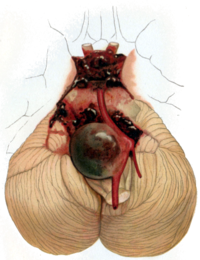
Photo from wikipedia
RATIONALE AND OBJECTIVES Interstitial fibrosis, common to most chronic kidney diseases, can potentially affect the speckle patterns of kidney ultrasound (US). Here we use Radiomics features derived from US images… Click to show full abstract
RATIONALE AND OBJECTIVES Interstitial fibrosis, common to most chronic kidney diseases, can potentially affect the speckle patterns of kidney ultrasound (US). Here we use Radiomics features derived from US images to identify kidneys with chronic kidney disease. MATERIALS AND METHODS B-mode US without speckle reduction was performed on a cohort of CKD patients (n = 75) and healthy subjects (n = 27). Images of the patients with renal cysts, agenesis and calculi were excluded. After background subtraction, regions of interest were selected from each kidney. Four hundred and sixty-five Radiomics features including first and second-order gray level statistics were calculated on the selected regions. Second-order features were also calculated on wavelet transformed images. A random forest model was used to identify the most important features that can differentiate healthy and diseased kidneys. The ten most important features, based on the Gini index, were used to train a support vector machine. Synthetic minority oversampling technique was used to remove over fitting. RESULTS Wavelet transformed, Gray Level Run Length Matrix based Normalized Run Length Non-uniformity, WT (LH) (GRLN) was identified as the most significant feature in differentiating CKD and healthy kidneys (accuracy - 0.85, sensitivity - 1.0). The mean WT (LH) GRLN of healthy kidneys (0.40 ± 0.01) was significantly higher (p < 0.01) than that of the CKD kidneys (0.24 ± 0.01). According to the Gini Index, the differentiability of WT (LH) GRLN was highest when the long axis of the kidney was oriented perpendicular to the columns of the image matrix. CONCLUSION Radiomics features based on wavelet transformation are sensitive to directionality of US speckle patters and can be successfully used to differentiate CKD and healthy US kidney images.
Journal Title: Academic radiology
Year Published: 2021
Link to full text (if available)
Share on Social Media: Sign Up to like & get
recommendations!